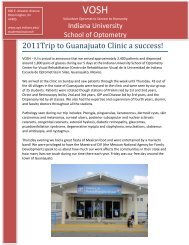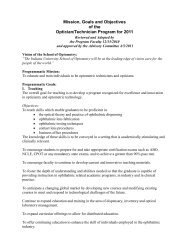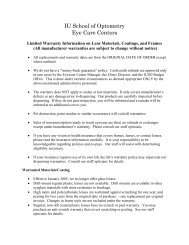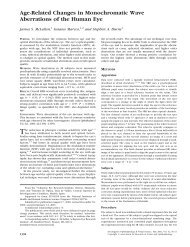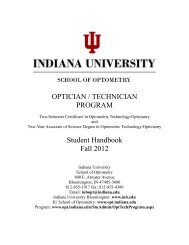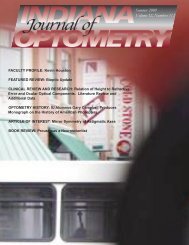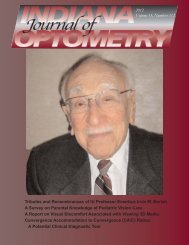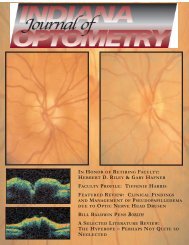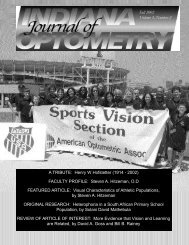Summer 2000 - Indiana University School of Optometry
Summer 2000 - Indiana University School of Optometry
Summer 2000 - Indiana University School of Optometry
Create successful ePaper yourself
Turn your PDF publications into a flip-book with our unique Google optimized e-Paper software.
tissue cleaned.<br />
LASIK has a unique safety issue not present with<br />
other refractive surgical procedures, which stems<br />
from the structural weakness <strong>of</strong> the corneal flap and<br />
its poor adhesion to the underlying corneal stroma. In<br />
some ways it is remarkable that the flap can<br />
"reattach" so easily without sutures. Initial<br />
reattachment results from hydrostatic pressure due to<br />
the hydrophilic nature <strong>of</strong> the inner cornea. Primary<br />
"reattachment" forces may result from capillary<br />
surface tension. It is therefore quite easy to remove<br />
the flap for additional photoablation, if the initial<br />
surgery was not as effective as desired. However,<br />
the flap can also become dislodged accidentally.<br />
Remarkably, this is very rare, but it can and does<br />
happen, usually following some ocular trauma. A<br />
notable concern exists for patients with dry eye who<br />
may experience adhesion forces between the anterior<br />
corneal surface and the lid. This has led to a patient<br />
waking to find the flap stuck to the lid. Also, because<br />
<strong>of</strong> the reduced sensitivity following surgery (sensory<br />
nerves have been cut) the normal feed-back that<br />
controls corneal insult has been seriously<br />
compromised which must increase the chances <strong>of</strong><br />
elevated mechanical forces on the cornea due to<br />
trauma or lid friction.<br />
In addition to flap displacement, the structural<br />
weakness <strong>of</strong> the flap and its attachment can lead to<br />
structural changes within the flap. Small scale<br />
"ripples" or "wrinkles" in the flap have been reported,<br />
as have larger folds. Flaps are sometimes detached<br />
and reattached to try and remedy flap irregularities.<br />
There is also the problem <strong>of</strong> accurately realigning the<br />
flap and replacing it in the correct location. Flap<br />
decentration has been reported. As with flap<br />
wrinkling, it will lead to reduced optical quality.<br />
The final complication associated with the flap<br />
surgery stems from the pre-incision protocol. In order<br />
for the keratome to make a precise cut, the corneal<br />
tissue must be held firmly by a vacuum ring. During<br />
this procedure, the intraocular pressure spikes to<br />
above 60 mm <strong>of</strong> Hg. There is some concern that this<br />
IOP spike, particularly if it is maintained for more than<br />
a few seconds, can lead to retinal damage. Suction<br />
duration depends upon the speed <strong>of</strong> the procedure<br />
and can vary significantly (e.g., from 6 to 80<br />
seconds). Changes in retinal blood flow and visual<br />
function following this transient elevated IOP have<br />
been reported. In addition to the IOP spike, there is<br />
some globe deformation associated with the vacuum<br />
ring.<br />
In the March <strong>2000</strong> issue <strong>of</strong> Biophotonics<br />
International, a new technology for producing the flap<br />
without a micro-keratome was described. A group at<br />
the <strong>University</strong> <strong>of</strong> Michigan are developing an infra-red<br />
laser to make the flap. This device uses a highly<br />
convergent laser beam with very high energy per<br />
square cm at its focal plane with sufficient energy to<br />
break the collagen fibers. By placing the focal plane<br />
within the stroma and scanning across the eye, the<br />
anterior cornea can be detached from the remaining<br />
posterior stroma and a flap produced. The<br />
advantages are that it requires no mechanical shear<br />
forces, which tend to move and distort the cornea and<br />
lead to variable flap thickness with micro-keratomes.<br />
Also, by optically adjusting the laser focal plane, the<br />
flap depth can be varied across the cornea and flaps<br />
with beveled edges can be produced. The<br />
technology is undergoing trials in Europe and may be<br />
introduced late in <strong>2000</strong> in the US. Interestingly for<br />
optometry, this device removes the necessity for<br />
cutting tissue with a blade, or traditional surgery, and<br />
may, in the classical sense, make LASIK a nonsurgical<br />
procedure.<br />
LASIK Summary<br />
The overall picture emerging from the LASIK<br />
literature indicates that it is a largely safe and<br />
effective treatment for myopia, hyperopia and<br />
astigmatism. However, LASIK is not risk free, and<br />
with current technology final vision quality will<br />
probably be slightly inferior to pre-surgical vision.<br />
Night vision may be significantly impaired. There are<br />
many stories <strong>of</strong> post-PRK and post-LASIK patients<br />
having to modify their night driving behavior because<br />
<strong>of</strong> seriously reduced vision at night. For the patient,<br />
the very small risk <strong>of</strong> serious complications and the<br />
likely small reduction in vision and night driving<br />
problems must be balanced against the obvious<br />
convenience <strong>of</strong> never having to worry about contact<br />
lenses or spectacles. Perhaps more significantly,<br />
highly myopic patients will never have to suffer the<br />
serious handicap that exists when their high myopia<br />
is uncorrected. For many patients, particularly those<br />
who are seriously handicapped by their myopia, and<br />
those for whom highest quality vision is not required,<br />
this may be the surgical treatment <strong>of</strong> choice at this<br />
time. However, it is imperative that all patients are<br />
made aware <strong>of</strong> the risks, particularly the commonly<br />
occurring reduced quality <strong>of</strong> vision and night driving<br />
problems.<br />
Thermokeratoplasty<br />
In addition to the photoablative use <strong>of</strong> short<br />
wavelength UV lasers, corneal irradiation using long<br />
wavelength (1.5 - 2.0 micron) lasers has been<br />
developed to create thermally induced changes in the<br />
corneal stroma. This method, Laser<br />
Thermokeratoplasty (LTK), has some obvious<br />
parallels to radial keratotomy, and it is sometimes<br />
referred to as radial thermokeratoplasty. Unlike RK,<br />
which treated myopia by introducing deep incisions to<br />
Page 10 ... Vol. 3, No. 1 ... <strong>Summer</strong> <strong>2000</strong> ... <strong>Indiana</strong> Journal <strong>of</strong> <strong>Optometry</strong> ........................................................



